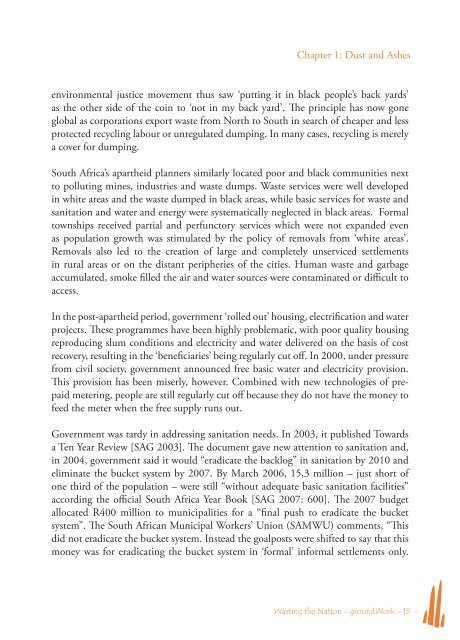Wasting the Nation.indd - Groundwork
Wasting the Nation.indd - Groundwork
Wasting the Nation.indd - Groundwork
You also want an ePaper? Increase the reach of your titles
YUMPU automatically turns print PDFs into web optimized ePapers that Google loves.
Chapter 1: Dust and Ashesenvironmental justice movement thus saw ‘putting it in black people’s back yards’as <strong>the</strong> o<strong>the</strong>r side of <strong>the</strong> coin to ‘not in my back yard’. The principle has now goneglobal as corporations export waste from North to South in search of cheaper and lessprotected recycling labour or unregulated dumping. In many cases, recycling is merelya cover for dumping.South Africa’s apar<strong>the</strong>id planners similarly located poor and black communities nextto polluting mines, industries and waste dumps. Waste services were well developedin white areas and <strong>the</strong> waste dumped in black areas, while basic services for waste andsanitation and water and energy were systematically neglected in black areas. Formaltownships received partial and perfunctory services which were not expanded evenas population growth was stimulated by <strong>the</strong> policy of removals from ‘white areas’.Removals also led to <strong>the</strong> creation of large and completely unserviced settlementsin rural areas or on <strong>the</strong> distant peripheries of <strong>the</strong> cities. Human waste and garbageaccumulated, smoke filled <strong>the</strong> air and water sources were contaminated or difficult toaccess.In <strong>the</strong> post-apar<strong>the</strong>id period, government ‘rolled out’ housing, electrification and waterprojects. These programmes have been highly problematic, with poor quality housingreproducing slum conditions and electricity and water delivered on <strong>the</strong> basis of costrecovery, resulting in <strong>the</strong> ‘beneficiaries’ being regularly cut off. In 2000, under pressurefrom civil society, government announced free basic water and electricity provision.This provision has been miserly, however. Combined with new technologies of prepaidmetering, people are still regularly cut off because <strong>the</strong>y do not have <strong>the</strong> money tofeed <strong>the</strong> meter when <strong>the</strong> free supply runs out.Government was tardy in addressing sanitation needs. In 2003, it published Towardsa Ten Year Review [SAG 2003]. The document gave new attention to sanitation and,in 2004, government said it would “eradicate <strong>the</strong> backlog” in sanitation by 2010 andeliminate <strong>the</strong> bucket system by 2007. By March 2006, 15,3 million – just short ofone third of <strong>the</strong> population – were still “without adequate basic sanitation facilities”according <strong>the</strong> official South Africa Year Book [SAG 2007: 600]. The 2007 budgetallocated R400 million to municipalities for a “final push to eradicate <strong>the</strong> bucketsystem”. The South African Municipal Workers’ Union (SAMWU) comments, “Thisdid not eradicate <strong>the</strong> bucket system. Instead <strong>the</strong> goalposts were shifted to say that thismoney was for eradicating <strong>the</strong> bucket system in ‘formal’ informal settlements only.<strong>Wasting</strong> <strong>the</strong> <strong>Nation</strong> - groundWork - 15 -
















